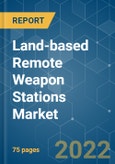The land-based remote weapon stations market is expected to exhibit a growth rate of more than 14% during the forecast period.
Key Highlights
- The use of remote weapon stations has grown over the recent past, particularly driven by the growth in asymmetric warfare. Non-state actors have started employing the techniques and tactics of asymmetric warfare, and conventional forces require new capabilities to become successful in modern combat situations and post-conflict scenarios. In this regard, the use of remote weapon systems is becoming widespread in several anti-terrorist and counter-insurgency operations.
- The increase in defense spending by major economies such as the United States, China, Russia, India, etc. on land combat systems such as armored vehicles, main battle tanks, etc. is driving the growth of market for land-based RWS.
- Recent innovations such as autonomous and unmanned defense vehicle technology, advancements in shock absorption technology, gyroscopic stabilization, compatibility with multiple weapons, ammunitions and platforms, integration of laser and infrared technology in situational awareness systems, etc. are supporting the growth of the market.
Key Market Trends
Technological Innovations are Driving the Market Growth
The increasing implementation of technologies such as Artificial Intelligence and robotics is driving the growth of the market for land-based Remote Weapon Stations across the world. The growth in the modernization of armored vehicles such as Main Battle Tanks, Infantry Fighting Vehicles, Armored Personnel Carriers, etc. for enhanced mobility and lethality has propelled the demand for remote weapon station (RWS) systems and almost every major country are developing or has already developed their own RWS systems. Advancement in Unmanned Ground Vehicles (UGV) technology has led to the introduction of Lethal Autonomous Weapon Systems including advanced RWS. AI-driven UGVs such as Giant Tiger (China), Ripsaw (United States), Vikhir (Russia), etc. are already deployed or undergoing development. The modern Land-based Remote Weapon Stations are equipped with multiple ammunition compatibility, optical sensors, gyroscopic stabilization, ballistic computers, smoke screen-generation system, etc. and can be integrated with Battle Management Systems for advanced data analytics and enhanced situational awareness. In 2019, the United States Army received a patent for its invention of anti-vibration mount compatible with remotely controlled Javelin Missile System, M240 Machine Gun, M2 Machine Gun, and Mk19 grenade launcher. The mount has a resonance mode higher than 30 Hz which prevents jamming of .50 calibre machine gun such as M2. Such developments will support the growth of the market in the coming years.
Asia-Pacific to Exhibit the Highest Growth Rate During the Forecast Period
Asia-Pacific countries such as India, China, Japan, Australia, South Korea, etc. are some of the top military spenders in the world. The rise in border conflicts, terrorism, territorial disputes are propelling the market growth for armored vehicles and static and mobile land-based Remote Weapon Station systems in the region. In February 2020, India’s Ordnance Factory Board unveiled its Remotely Operated Weapon System (ROWS) at DefExpo 2020. The new ROWS has a Russian NSVT 12.7 mm heavy machine gun mounted on a two-axis stabilizer that can engage ground and aerial targets. South Korea is planning to upgrade its K1A2 Main Battle Tank with high-performance armor, enhanced engine, environmental control system and an advanced remote weapon station. Latest Remote Weapon Stations capable of detecting 50 targets at a time and thermal camera range up to 2 kilometers were also displayed at Seoul International Aerospace and Defense Exhibition (ADEX) 2019 by companies such as Hyundai. In December 2019, Australia signed a USD 45 million contract with Electro Optic Systems Holdings Limited for the procurement of 82 advanced Remote Weapon Stations for Boxer 8X8 armored vehicles. China is also making significant investments in Artificial Intelligence-powered autonomous weapon systems and this factor will propel the market growth in the country during the forecast period.
Competitive Landscape
The land-based RWS Market is fragmented. Some of the prominent players in the market are FN Herstal, Elbit Systems Limited, Rheinmetall AG, General Dynamics Corporation, and Rafael Advanced Defense Systems Ltd. among others. The market is witnessing a high growth rate due to investments in technological developments, upgrade and modernization of the existing armored fleet, etc. The market presents a huge opportunity for key players to generate revenue through contracts from defense agencies as many governments are considering the significant use of autonomous systems.
Additional Benefits:
- The market estimate (ME) sheet in Excel format
- 3 months of analyst support
This product will be delivered within 2 business days.
Table of Contents
Methodology

LOADING...








